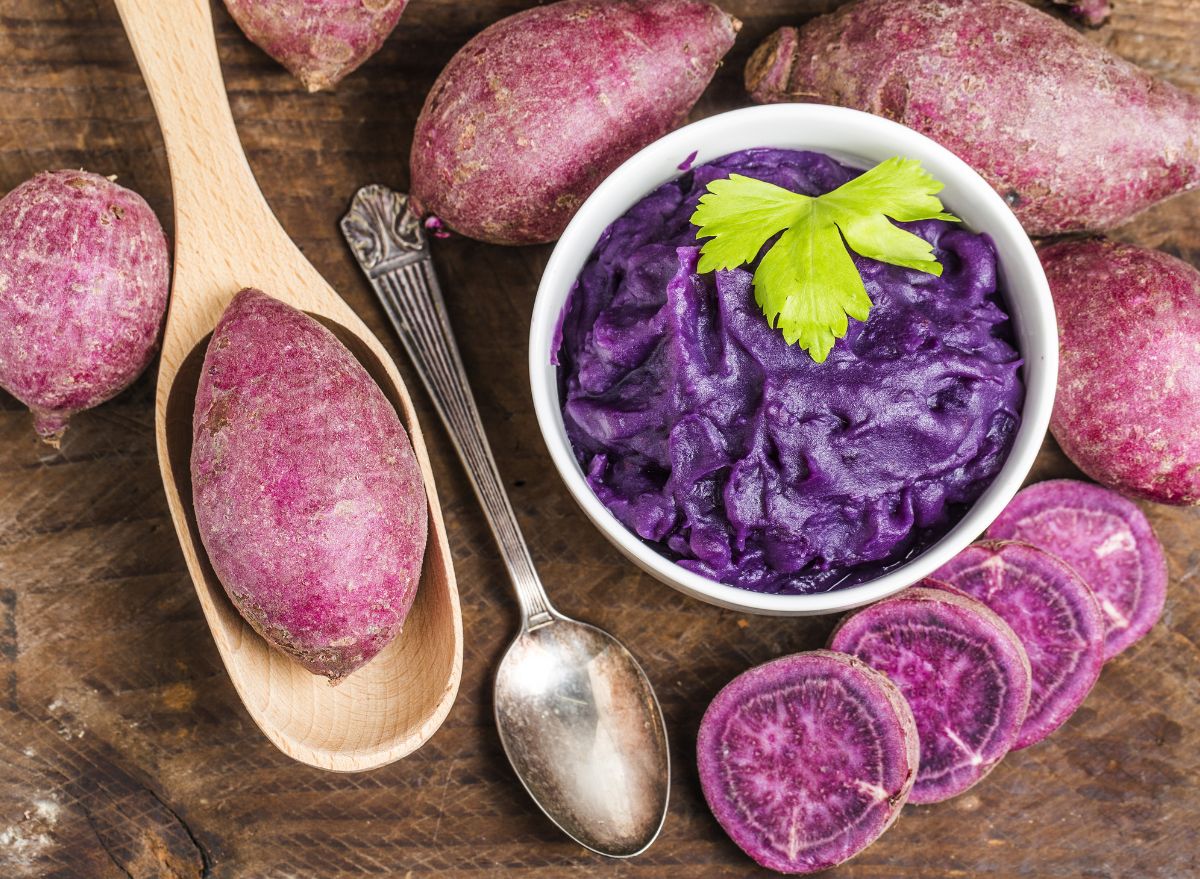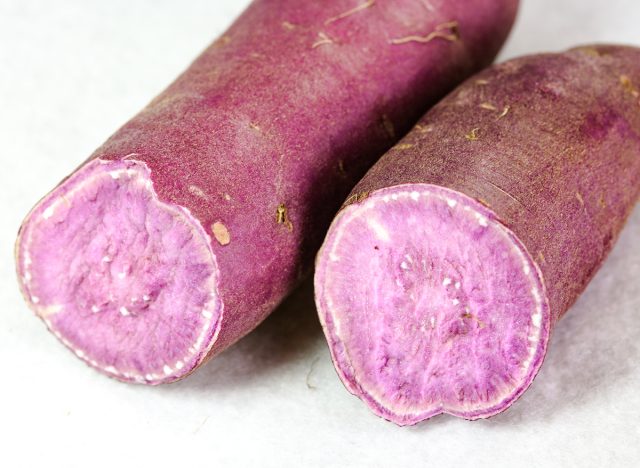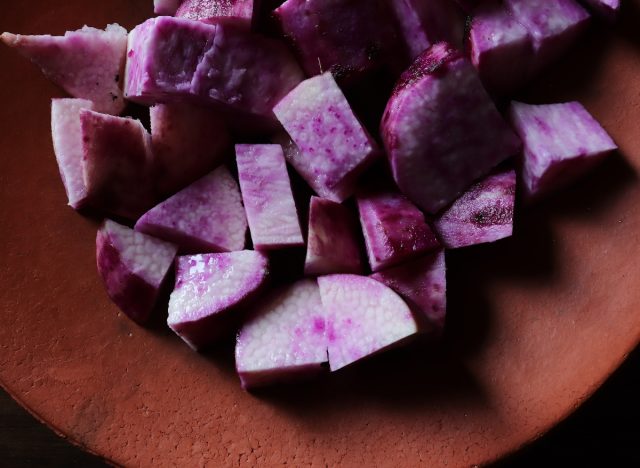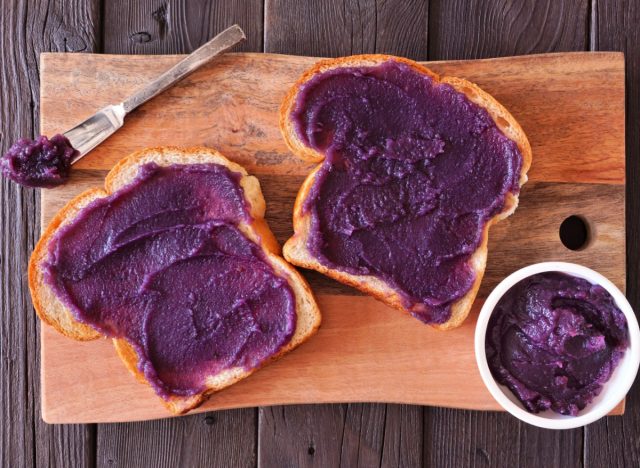Everything You Need To Know About Ube, the Latest Viral Veggie

Among the many eye-catching foods flooding social media feeds is one versatile, vibrant vegetable, which is transformed in various ways. Perhaps you've come across bright purple donuts, ice cream, and hamburger buns while scrolling through Instagram. Maybe you've encountered a box of violet-hued pancake mix while shopping at Trader Joe's. Despite being different in form, all of these foods can attribute their striking color to the same key element: ube (pronounced "oo-bay").
While commonly associated with its distinctive purple shade, there's more to ube than meets the eye. Here's what you need to know about this aesthetically pleasing ingredient.
What is ube?

Translating to "tuber" in Tagalog (one of the languages spoken in the Philippines), ube is a purple yam native to Southeast Asia, commonly used in Filipino cuisine. While similar to purple sweet potatoes, ube has a darker, bark-like skin and grows on a vine. Purple sweet potatoes, on the other hand, grow underground and have a smoother skin that can be purple or white, depending on the variety.
Often seen in desserts, ube has been reported to have a mildly sweet, nutty, vanilla flavor. Amy Goodson, MS, RD, CSSD, LD, registered dietitian and author of The Sports Nutrition Playbook, adds that the vegetable has a "coconut-like aroma."
Although ube has been used for centuries, according to a report from Forbes, the root vegetable rose to fame in the United States after Manila Social Club, a former Brooklyn, NY-based Filipino restaurant, released its $100 Golden Cristal Ube Donut in 2015.
What are the health benefits of this root vegetable?

"Like other yam varieties, [ube] is a great source of carbs, fiber, and many micronutrients, including calcium, vitamin C, and iron," says Lauren Manaker, MS, RDN, registered dietitian and author of The First Time Mom's Pregnancy Cookbook and Fueling Male Fertility.
According to the U.S. Department of Agriculture (USDA), 100 grams (3.5 ounces) of ube contains:
- 120 calories
- 1 gram of protein
- 0 grams of fat
- 27 grams of carbs
- 4 grams of fiber
- 0 grams of sugar
- 20 milligrams of calcium (2% DV)
- 0.36 milligrams of iron (2% DV)
- 12 milligrams of vitamin C (13% DV)
- 100 IU of vitamin A (11% DV)
Within its nutritional composition, ube also contains anthocyanins, which are antioxidants known for giving fruits and vegetables their signature red, blue, and purple colors. These water-soluble pigments have been shown to protect cells from damage caused by free radicals. They've also been tied to reduced inflammation and protection against disease.
Additionally, "ube is both blood sugar-friendly and gut-healthy," Goodson notes. The dietitian highlights the vegetable's low glycemic index, explaining that this "means that the carbs are broken down into sugars slowly, which helps you maintain energy levels instead of a quick spike." In terms of gut health, ube offers resistant starch, a type of starch that has been found to play a role in supplying the gut with healthy bacteria.
Why is it so popular?
Although much of the attention directed toward ube can be connected to its attention-grabbing color, Manaker says the purple yam's appeal goes beyond appearance.
"While this root veggie has been popular for years in certain areas of the world, it is only gaining popularity here in the U.S. among groups of people who have never been exposed to it before," she says. "People are being encouraged to explore new foods that are part of other cultures, and because of this, ube may be appealing to try."
How to eat ube

Another upside to ube is its incredible versatility.
Classic Filipino recipes starring this ingredient include ube halaya, a sweet jam made with boiled and mashed ube, and halo-halo, which consists of shaved ice, evaporated milk, and toppings like ube, coconut strips, and tapioca.
If you're looking for something sweet, Goodson recommends making a three-ingredient, no-churn ube ice cream with sweetened condensed milk and heavy whipping cream. For a savory option, she suggests ube hummus, which uses the root vegetable instead of the usual chickpeas found in the popular dip.
"Cooking ube is no different than boiling a sweet potato," says Goodson. Just like a yam or potato, the purple tuber can be baked, fried, mashed, and so on. "You can also purchase ube extract and ube powders to throw into a recipe," she adds.
- Source: https://plants.ifas.ufl.edu/plant-directory/dioscorea-alata/
- Source: https://www.ncbi.nlm.nih.gov/pmc/articles/PMC5613902/#:~:text=Introduction,anthocyanin%20exists%20in%20alkaline%20conditions.
- Source: https://www.ncbi.nlm.nih.gov/pmc/articles/PMC7504512/
- Source: https://www.researchgate.net/publication/281675400_Estimation_of_Nutritional_and_Starch_Characteristics_of_Dioscorea_alata_Water_Yam_Varieties_Commonly_Cultivated_in_the_South-Eastern_Nigeria
- Source: https://pubmed.ncbi.nlm.nih.gov/29620784/









